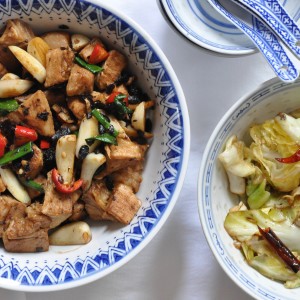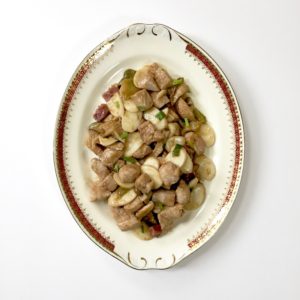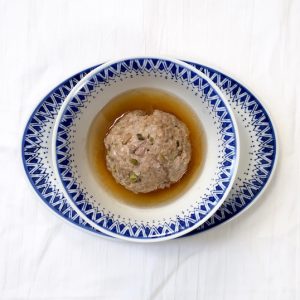Mu-Shu Pork
When I was a child, I knew a woman who collected penguin figurines. When the local fish place went out of business, she acquired their namesake, a ten-foot tall penguin, and had it installed in her yard. The interior of her home was equally penguin (penguinic? penguinesque?): the garbage cans, the soap dishes, the towels. Her daughter, while not a penguin, was understandably rather odd.
Which is to say, there are stranger things to collect than woks.

When the above wok presented itself last week, I did not resist. Reader, I bought it. The IK now boasts four woks.

(Attractive filler shot.)
You need only one wok–or large frying pan–to prepare Mu-shu pork. Hailing from northern China, this classic recipe is usually served with a stack of Chinese pancakes alongside. Diners place a bit of Mu-shu pork on the pancake, roll it up, and eat–much like the Tex-Mex fajita. In fact, Chinese cookbooks often suggest substituting tortillas for pancakes. More on this shortly.

Consult several Chinese cookbooks, as your hostess did while preparing this post, and you’ll notice Mu-shu pork recipes share a backbone: pork, day lily bulbs, wood ear mushrooms, bamboo shoots, garlic, rice wine, scallions, and cooking oil. Serious cookbooks also give pancake recipes.

I was unable to locate Chinese pancakes at the Asian market, and found tortillas too thick. Making them appealed to mind but not wrist. So I confess, shamefaced, that we ate Mu-shu pork with rice.

While we’re in confessional mode, let us discuss the egg in Mu-shu pork. It was scrambled in a nonstick wok. One of the four, if you must know. Also, I took the above photograph a long time ago. But it works for our purposes.

Mu-shu pork requires ingredients not found at the corner shop (unless you live in a Chinatown). Visit an Asian market, order online, or move.
Day lily bulbs are sold in plastic bags. Look for them in Asian markets; I found mine at Ranch 99 in same aisle as dried fungi. Like many Chinese ingredients, they’re more about texture than strong flavor.

Dried wood ear mushrooms are sometimes labeled “dried black fungus.” Look for them in the international or Asian food aisles in larger supermarkets.

Fresh wood ear mushrooms are available during the fall months. A few weeks ago I watched as an elderly Chinese woman bought all the mushrooms on display, exclaiming she had not seen fresh wood ears since her youth. She was near tears.

Frozen bamboo shoots are infinitely better than canned; find them in Asian markets. If fresh bamboo shoots are available, grab them and run. (Pay for them first.)

This recipe reads much longer than it takes to cook. Please don’t be intimidated. Short of burning the food, or yourself, Mu-shu pork is hard to mess up.

Mu-Shu Pork
adapted from:
The Mandarin Way by Cecilia Chiang with Allan Carr
All Under Heaven by Carolyn Phillips
The Modern Art Of Chinese Cooking by Barbara Tropp
Mastering The Art Of Chinese Cooking by Eileen Yin-Fei Lo
Serves 2-4 people
Preparation time: about one hour; most of this is prep. Actual cooking time is about ten minutes.
Please read the entire recipe through before cooking. Stars * indicate places where you can take a break.
Mu-shu Pork is best prepared in a 14-inch/35 cm carbon steel wok. If you don’t have a wok, a sauteuse or wide, heavy pan will work. Avoid nonstick pans.
The recipe calls for scrambling eggs. After warning you off nonstick, I confess to scrambling the eggs in a nonstick wok over lower heat. If your wok or pan is well seasoned and you’re confident the eggs won’t stick, use it.
Authentic Mu-shu pork is served with Chinese pancakes. These are sold in Asian markets. While many cookbooks recommend tortillas as a substitute, I found them too thick. A thin, flexible flatbread will suffice, but in an ideal world, we would all make the pancakes. This said, we eat Mu-shu pork with rice, which is inauthentic but delicious.
Ingredients
1/4 cup/35 g dried wood ear mushrooms or 5 fresh ones
1/4 cup/35 g day lily bulbs (Carolyn Phillips suggests substituting one peeled, sliced carrot if wished)
One pound/454 g boneless pork, either well-trimmed chops or loin (beef or tofu may be used)
For the marinade:
2 tablespoons regular soy sauce
2 tablespoons Shaoxing rice wine
2 tablespoons water
2 teaspoons potato or cornstarch
For the vegetables:
2 large garlic cloves
1 cup/8 ounces/225 g bamboo shoot: either fresh, frozen, or canned.
2 scallions
about 2 tablespoons Shaoxing rice wine, for the wok
Sesame or peanut oil, for the wok
To scramble the eggs:
3 large eggs
Additional sesame or peanut oil, for the wok
For the sauce:
3 tablespoons hoisin sauce
2 tablespoons chicken broth (low salt if purchased; use water if all else fails)
2 tablespoons dark or regular soy sauce
2 tablespoons Shaoxing rice wine
1 tablespoon cornstarch
3/4 teaspoon salt
1/2 teaspoon-3 1/2 teaspoons sugar
Slivered scallion for the top, optional
Mandarin pancakes, for serving, or, nontraditionally, rice (see above discussion)
Instructions
Soak the dried ingredients first. If you have both dried wood ear mushrooms and dried lily bulbs, they can be soaked together in about a cup of boiling water.
If you have a fresh bamboo shoot, prepare it now, as they take time to cook. Peel the outside barky layer until you reach to inner creamy part. Place in a saucepan, cover with water, and bring to boil. Turn heat down to simmer and cook until tender, 20-60 minutes. Drain, pat dry, and slice.
*
While the dried ingredients soak, prepare the pork and marinade:
Place pork in freezer to firm up if necessary; this helps in slicing.
In a large bowl, blend the soy sauce, rice wine, water, and potato or cornstarch with a fork. Slice pork into chopstick-sized pieces and add to marinade. Stir to coat; I find my clean hands do the best job, but use a large spoon if you prefer. Set the bowl aside.
(If you want a break, refrigerate your pork.)*
Prep vegetables and eggs:
If using fresh wood ear mushrooms, rinse and pat dry. Slice into strips. Slice scallions thinly. Crush garlic lightly to peel it, then slice thinly. Arrange these items on a cutting board or in small bowls and have them within reach of stove.
If using frozen bamboo shoots, slice and dry well, or they’ll spit while stir-frying and may burn you. Set with above ingredients so it’s within reach while cooking.
Drain lily bulbs and dried wood ears. Again, arrange within reach of stove.
Make the sauce:
In a medium bowl, whisk together hoisin sauce, chicken broth or water, dark or regular soy, Shaoxing rice wine, cornstarch, salt and sugar. Set near stove.
Crack eggs into a medium bowl. Whisk lightly and set near stove.
Have the pork, rice wine, and cooking oil ready to go.
Get a large, clean bowl and set it near the stove.
Cook the Mu-shu pork:
If being inauthentic like me, start your rice now.
If using a nonstick pan to scramble your eggs, set on stove. Or use the wok. Either way, pour about two tablespoons sesame oil into the pan. Turn the heat to medium. Now tip the eggs into the pan and scramble, cooking until just done. The eggs will be added to the wok later, so don’t overcook now. When curds are just set, scrape into waiting bowl.
If you’ve cooked eggs in the wok, turn off heat and wipe it out with paper towel. Now reheat wok. Or heat a clean wok. Either way, add more cooking oil and tip in the pork, marinade and all, and stir fry until just cooked through. This takes just a few minutes. Be careful not to overcook. Scrape the pork into the bowl with the eggs.
No need to wipe the wok this time. Add more oil if necessary–it likely will be. Now add garlic, bamboo shoots, daylilies (or carrot), wood ears, and scallions. Stir fry briefly, until aromas rise, about one minute.
Add the pork and egg back to the wok, and stir. Add the rice wine, and now quickly scrape in the sauce. Stir fry vigorously, cooking on medium high heat until everything blends and is cooked through–a matter of three or four minutes, tops.
Taste for salt–it’s unlikely to need any–and turn the Mu-shu pork onto a deep platter or into deep individual bowls. Top with slivered scallion. Serve with Chinese pancakes, to be authentic, or rice, to be inauthentic.
Mu-shu pork keeps, refrigerated in a covered container, up to four days, but I’ve never had any last that long.
Variations:
Carolyn Phillips stir fries garlic first, then scrambles eggs and garlic together.
Cecilia Chiang and Barbara Tropp make their eggs into an omelet, which they top the Mu-shu with. Diners break the omelet into pieces as they eat.
Notes:
Wood ear mushrooms are also sold as “dried black fungus.”
Leftover fresh bamboo shoot should be treated like tofu: refrigerate it, covered with water, up to five days, changing water daily.
Most Mu-shu recipes call for adding 1-4 teaspoons of sugar. I prefer far less and add barely a quarter teaspoon. Add to your taste.
Sesame oil is generally drizzled over a finished dish, not used throughout. It truly does make this dish more delicious, but it’s not required. Use peanut or another high-heat neutral oil if you prefer.
Asian markets sell soy sauce, rice wine, sesame, and peanut oils in gallon jugs. This is an economical way to purchase these stir-fry staples.





